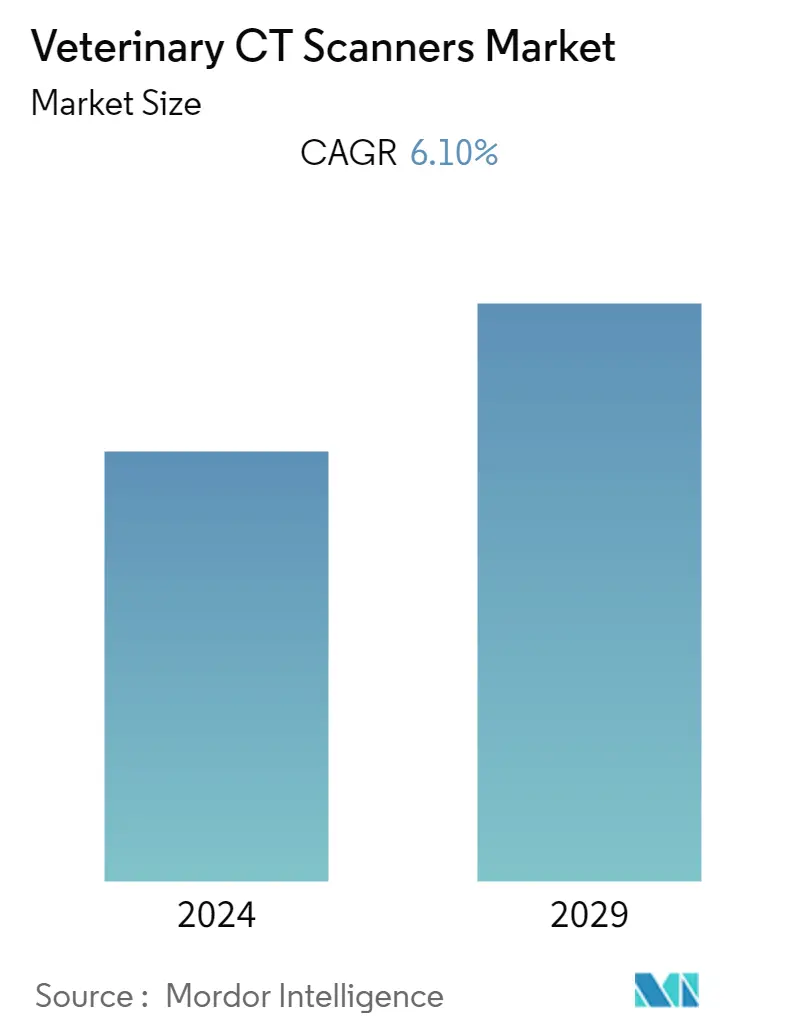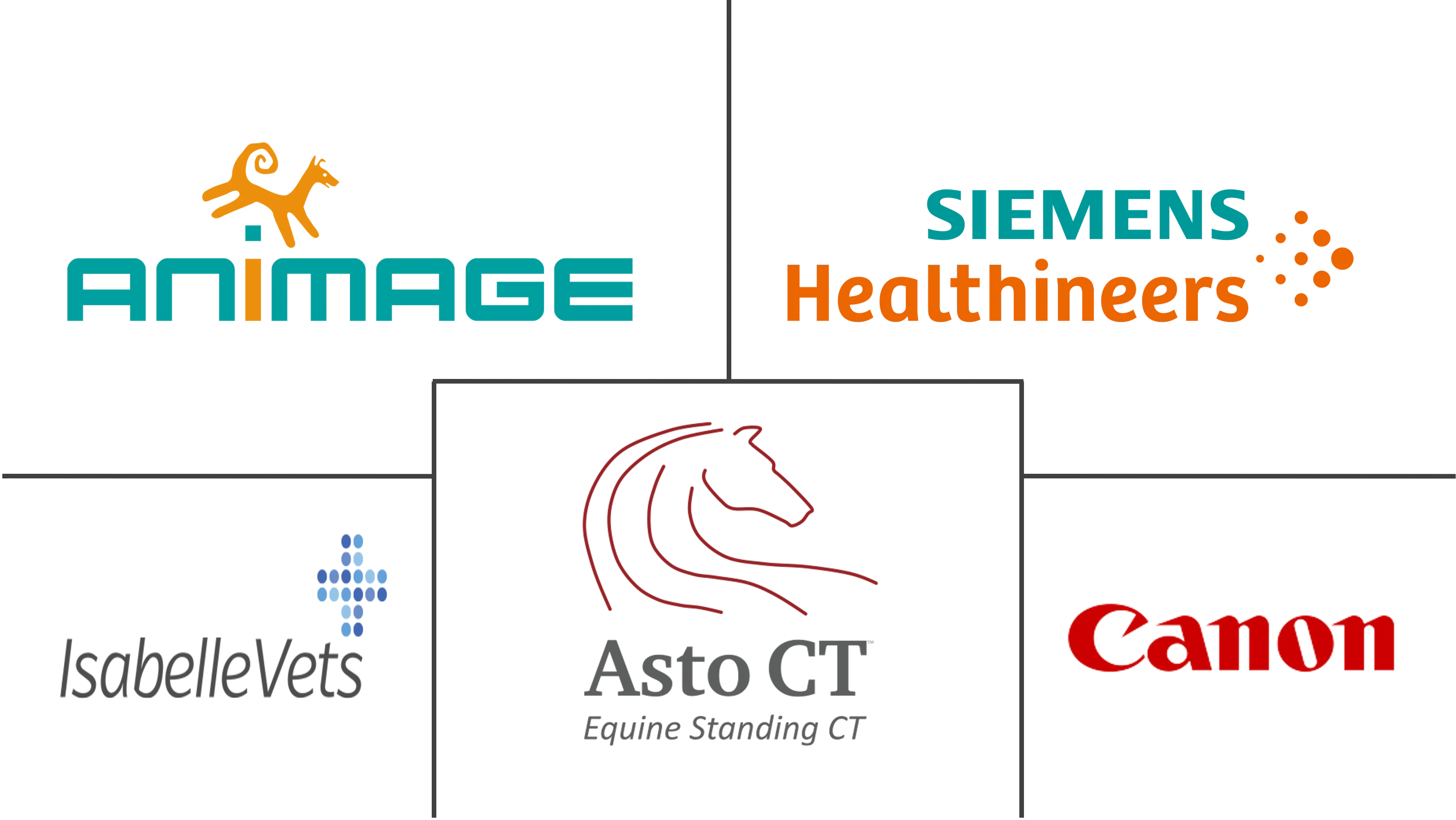Market Size of Veterinary CT Scanners Industry

| Study Period | 2019 - 2029 |
| Base Year For Estimation | 2023 |
| CAGR | 6.10 % |
| Fastest Growing Market | Asia Pacific |
| Largest Market | North America |
| Market Concentration | Medium |
Major Players
*Disclaimer: Major Players sorted in no particular order |
Veterinary CT Scanner Market Analysis
The veterinary CT scanners market is expected to register a CAGR of 6.1% over the forecast period.
- The COVID-19 pandemic had a significant impact on the market due to the healthcare system's diverted focus on managing COVID-19 patients. However, the market started to gain traction as pet adoption increased during the pandemic, which propelled the demand for veterinary care services.
- For instance, according to the People's Dispensary for Sick Animals (PDSA), 2 million people in the United Kingdom acquired a pet between March 2020 and May 2021. Of these pets, 10% were dogs, 8% were cats, and 13% were rabbits. Such a high rate of pet adoption in different regions worldwide increased the focus on animal healthcare. This increased the incidence of veterinary diagnostics, thus increasing the demand for veterinary computerized tomography (CT) scanners and boosting the market growth.
- The market is expected to rise due to increasing awareness, technological advancements, and product launches in the veterinary CT scanners market for treating animal diseases.
- New product launches are contributing significantly to market growth. For instance, in May 2021, Xoran Technologies announced that reservations were being accepted for its new open-bore CT scanner - vTRON, which was launched at the Veterinary Meeting and Expo (VMX) conducted in June 2021 in Orlando, United States. This introduction to Xoran's suite of CT systems offered a revolutionary imaging solution specifically designed for veterinary hospitals and general practice clinics.
- In addition, increased pet ownership has increased animal health expenditure, and the rising prevalence of animal diseases and injuries is actively affecting the growth of the market studied. According to the Universities Federation for Animal Welfare (UFAW) data published in November 2021, lameness is caused by injury or disease in the foot or leg, causing problems for dairy cattle.
- Also, in the United Kingdom, the estimated prevalence of dairy cow lameness was around 22.1% during the year 2021. Furthermore, according to the Multidisciplinary Digital Publishing Institute (MDPI) data published in March 2021, the prevalence rates of lameness in dairy herds ranged from 17% to 35% globally. The high prevalence of such diseases expedites the utility of CT scanners for diagnostic purposes, which is further expected to propel the growth of the market during the forecast period.
- Therefore, owing to the abovementioned factors, it is anticipated that the market studied will witness growth over the forecast period. However, the high cost of CT imaging devices and low awareness of animal health in emerging markets are likely to impede the market's growth.
Veterinary CT Scanner Industry Segmentation
Computerized tomography (CT) scan combines a series of X-ray images taken from different angles around the body and uses computer processing to create cross-sectional images of the bones, blood vessels, and soft tissues inside the body.
The veterinary CT scanners market is segmented by product type (stationary multi-slice CT scanner, portable CT scanner), animal type (companion animal, livestock animal, and other animal types), application (neurology, oncology, cardiology, nephrology, gastroenterology, and other applications), end-user (veterinary hospitals, research institutes, and other end-users), and geography (North America, Europe, Asia-Pacific, Middle East and Africa, South America). The report also covers the estimated market sizes and trends for 17 countries across major global regions.
It offers market sizes and forecasts in terms of value in USD.
| By Product Type | |
| Stationary Multi-slice CT Scanner | |
| Portable CT Scanner |
| By Animal Type | |
| Companion Animal | |
| Livestock Animal | |
| Other Animal Types |
| By Application | |
| Neurology | |
| Oncology | |
| Cardiology | |
| Nephrology | |
| Gastroenterology | |
| Other Applications |
| By End-User | |
| Veterinary Hospitals | |
| Research Institutes | |
| Other End-Users |
| Geography | ||||||||
| ||||||||
| ||||||||
| ||||||||
| ||||||||
|
Veterinary CT Scanners Market Size Summary
The veterinary CT scanner market is poised for growth, driven by increasing pet adoption and heightened awareness of animal healthcare. The COVID-19 pandemic initially disrupted the market, but it rebounded as more people adopted pets, leading to a surge in demand for veterinary care services. This trend has been further bolstered by technological advancements and new product launches, such as Xoran Technologies' vTRON CT scanner, which offers innovative imaging solutions for veterinary applications. The rising prevalence of animal diseases and injuries, coupled with increased pet ownership and health expenditure, is expected to propel the market forward. However, challenges such as the high cost of CT imaging devices and limited awareness in emerging markets may hinder growth.
North America is anticipated to lead the market due to the growing companion animal population, increased incidence of animal diseases, and a strong presence of industry players. The region's market growth is also supported by the rising number of pet insurance policies, which encourage higher spending on pet healthcare. The demand for CT scanners is expected to rise as pet owners seek advanced diagnostic solutions for various diseases, including musculoskeletal conditions like osteoarthritis. The competitive landscape of the market is moderately fragmented, with key players such as Siemens Healthineers, Canon Medical System Corporation, and GE Healthcare actively contributing to market dynamics through innovations and strategic partnerships.
Veterinary CT Scanners Market Size - Table of Contents
-
1. MARKET DYNAMICS
-
1.1 Market Overview
-
1.2 Market Drivers
-
1.2.1 Increased Pet Ownership and Animal Health Expenditure
-
1.2.2 Rising Prevalence of Animal Diseases and Injuries
-
-
1.3 Market Restraints
-
1.3.1 High Cost of CT Imaging Devices
-
1.3.2 Low Animal Health Awareness in Emerging Markets
-
-
1.4 Porter's Five Forces Analysis
-
1.4.1 Threat of New Entrants
-
1.4.2 Bargaining Power of Buyers/Consumers
-
1.4.3 Bargaining Power of Suppliers
-
1.4.4 Threat of Substitute Products
-
1.4.5 Intensity of Competitive Rivalry
-
-
-
2. MARKET SEGMENTATION (Market Size by Value - USD)
-
2.1 By Product Type
-
2.1.1 Stationary Multi-slice CT Scanner
-
2.1.2 Portable CT Scanner
-
-
2.2 By Animal Type
-
2.2.1 Companion Animal
-
2.2.2 Livestock Animal
-
2.2.3 Other Animal Types
-
-
2.3 By Application
-
2.3.1 Neurology
-
2.3.2 Oncology
-
2.3.3 Cardiology
-
2.3.4 Nephrology
-
2.3.5 Gastroenterology
-
2.3.6 Other Applications
-
-
2.4 By End-User
-
2.4.1 Veterinary Hospitals
-
2.4.2 Research Institutes
-
2.4.3 Other End-Users
-
-
2.5 Geography
-
2.5.1 North America
-
2.5.1.1 United States
-
2.5.1.2 Canada
-
2.5.1.3 Mexico
-
-
2.5.2 Europe
-
2.5.2.1 Germany
-
2.5.2.2 United Kingdom
-
2.5.2.3 France
-
2.5.2.4 Italy
-
2.5.2.5 Spain
-
2.5.2.6 Rest of Europe
-
-
2.5.3 Asia-Pacific
-
2.5.3.1 China
-
2.5.3.2 Japan
-
2.5.3.3 India
-
2.5.3.4 Australia
-
2.5.3.5 South Korea
-
2.5.3.6 Rest of Asia-Pacific
-
-
2.5.4 Middle East and Africa
-
2.5.4.1 GCC
-
2.5.4.2 South Africa
-
2.5.4.3 Rest of Middle East and Africa
-
-
2.5.5 South America
-
2.5.5.1 Brazil
-
2.5.5.2 Argentina
-
2.5.5.3 Rest of South America
-
-
-
Veterinary CT Scanners Market Size FAQs
What is the current Veterinary CT Scanners Market size?
The Veterinary CT Scanners Market is projected to register a CAGR of 6.10% during the forecast period (2024-2029)
Who are the key players in Veterinary CT Scanners Market?
Siemens Healthineers, Isabelle Vets, Canon Medical System Corporation, Asto CT, Inc. and Animage LLC are the major companies operating in the Veterinary CT Scanners Market.

